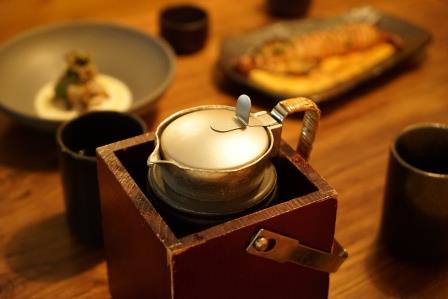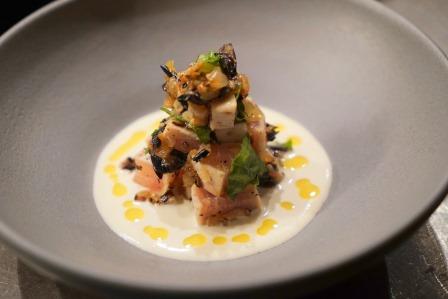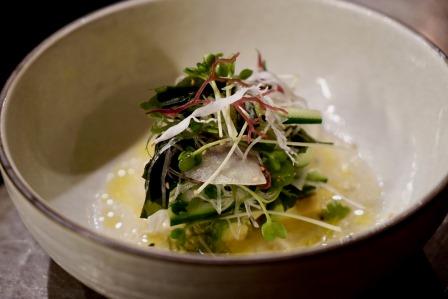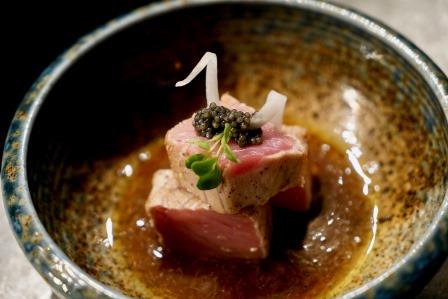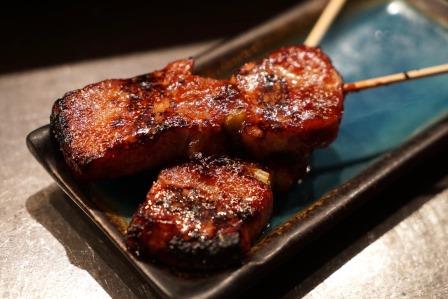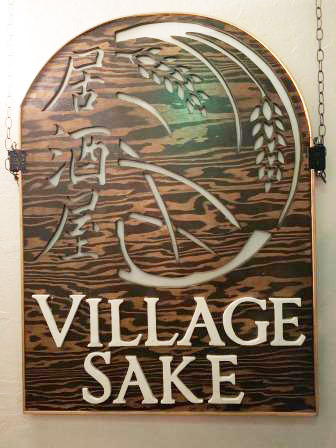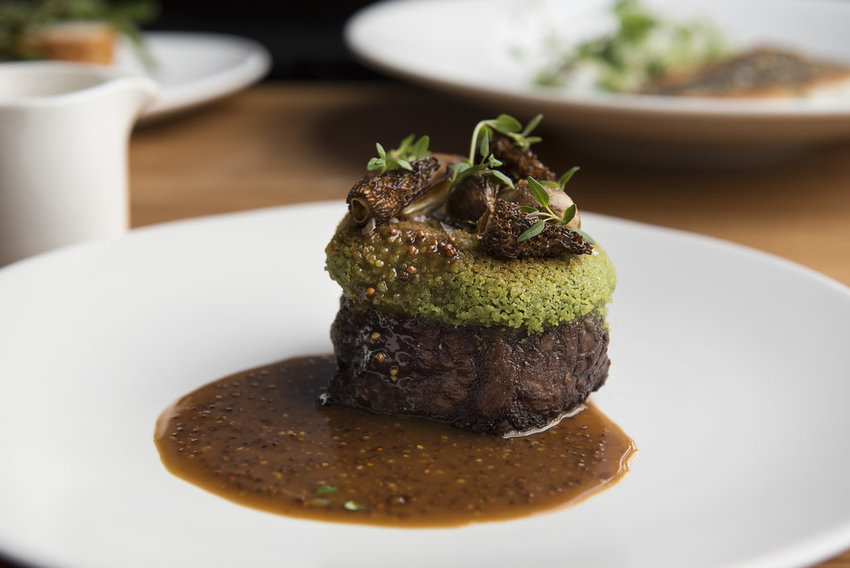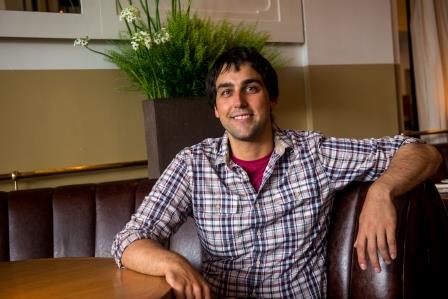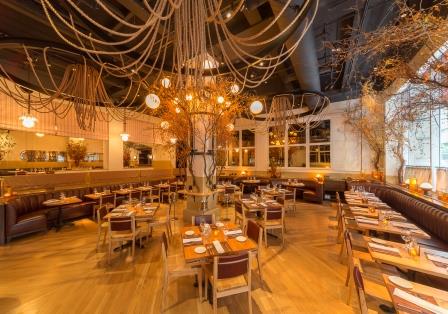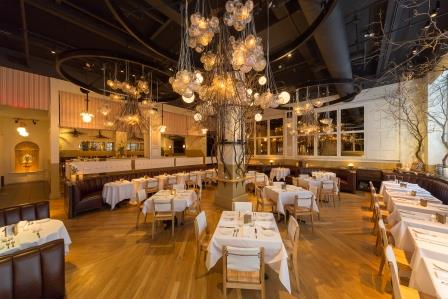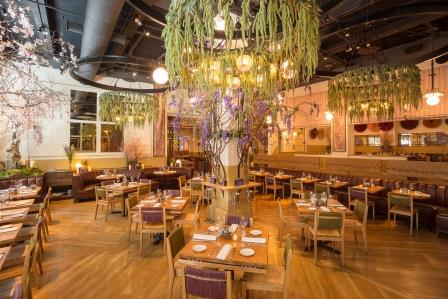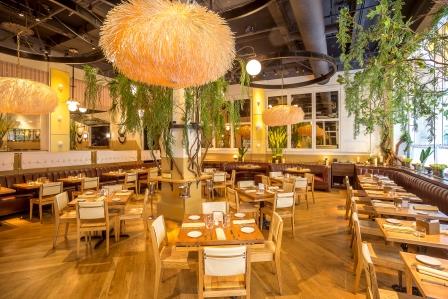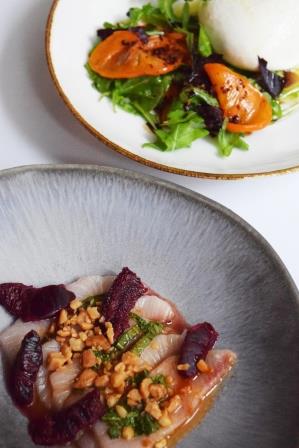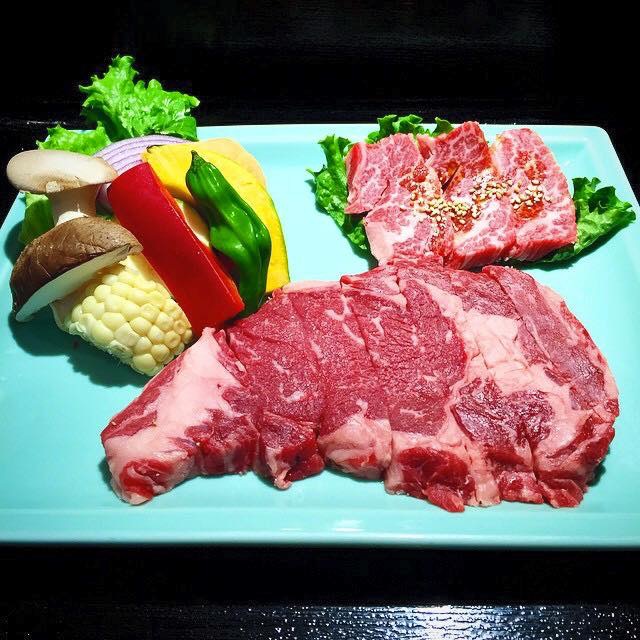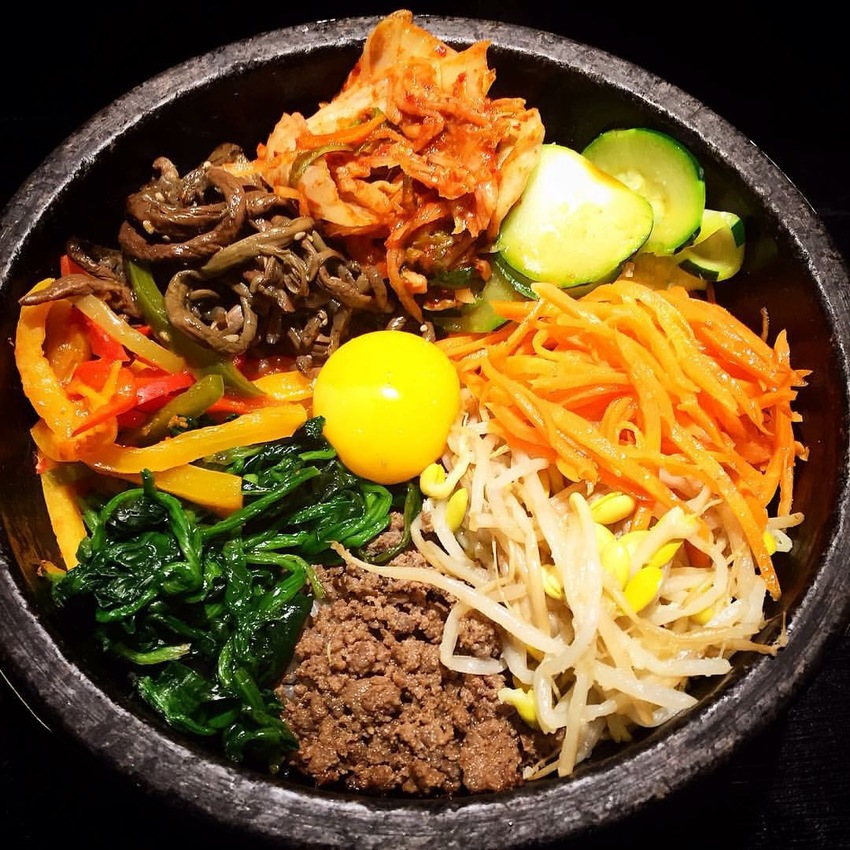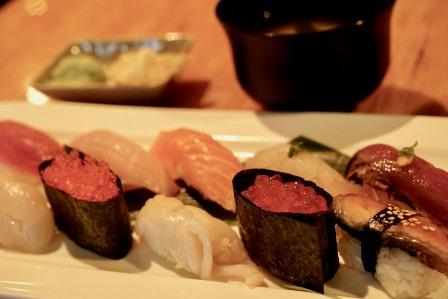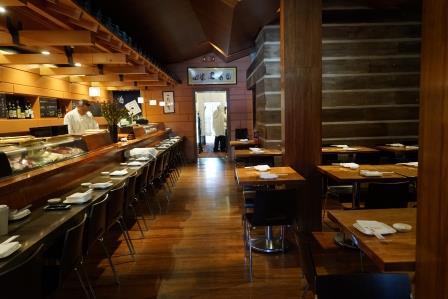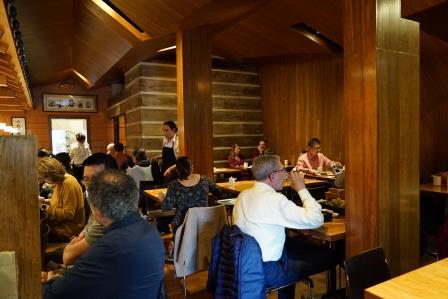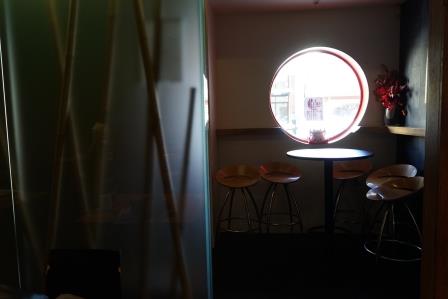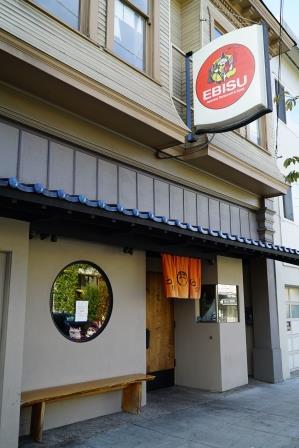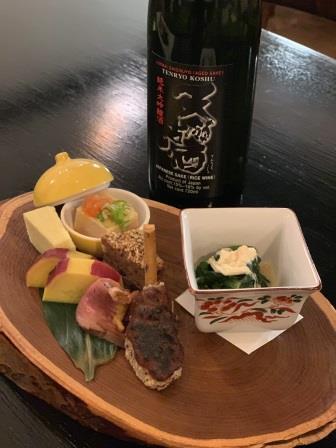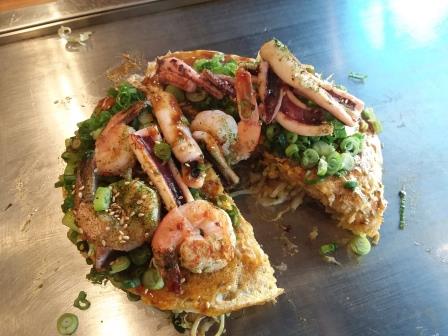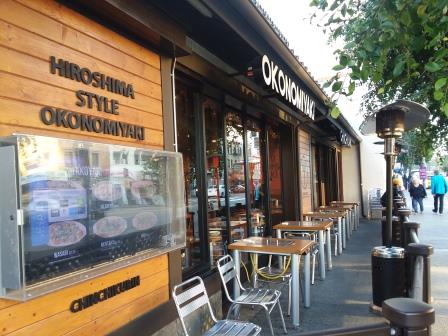The way a new-generation American-style Izakaya should be
By Elli Sekine
The Japanese cuisine boom in San Francisco has been more and more diversified every year, and the number of restaurants which are run by non-Japanese owners is increasing. In the Bay area, Michelin-starred Japanese and non-Japanese restaurant owners share a 50/50 ratio. Highquality and unique Japanese restaurants are spreading to the suburbs, and people are talking about them everywhere. I heard about such a restaurant existing in Fairfax, a small suburban town of San Francisco, which is run by a couple of American co-owners. I decided to go there to make a report.
This little town possesses some local power. The “Good Earth” (a sustainable super market) born in Fairfax has experienced rapid growth supported by its local residents. There are many small individual stores in the town center, and those markets, cafes, and restaurants lined up on the streets are creating a warm and relaxed scenery. On one such street, I saw people gathering around. It was a line of people waiting for the opening of the only Japanese restaurant in town, “Village Sake”. I asked them how they felt about the restaurant. The customers in the line, who made up a wide variety of age groups commended on the restaurant, in a way that reflected how much the restaurant was loved by the local people.
The place of topic is the first restaurant run by Scott Whitman and Scott Porter. It is an Izakaya-style restaurant which is high-end, yet casual. Chef Whitman worked for “Fog City Diner”, a long-established San Franciscan American cuisine restaurant chain in Osaka for 15 years as a staff member since its opening in Osaka in the nineties. While working there, he fell deeply for the charms of Japanese cuisine, and after returning to the US, he worked for “Sushi Ran”, a highend Japanese restaurant, as a chef, and earned a good reputation for his great skills. In the meantime, ideas for new recipes and a concept for his own place started to grow in his head. In 2015, they opened “Village Sake” in Fairfax, where both of them were born and raised. Mr. Porter, who named the place as a village, expressed his love for the region as follows, “Doesn’t this name sound cool? I imagined a place where local folks gather to mingle by eating and drinking.” Surprisingly, Mr. Porter also has an active career as a fire fighter. I asked him why he tried for an unfamiliar field, which was to run a restaurant. He answered, “I like to eat. You live only once, so I wanted to try different things.” He was born and raised in the same town as Mr. Whitman, and they were not only friends, but roommates as well.
The restaurant’s casual looking interior space that contains grainy wooden tables which give a feel of warmth of wood with effective warm illuminations, provides a cozy Izakaya atmosphere. Japanese-style partitions are installed to help maintain your privacy and comfort. Their efficient looking staff members are all friendly, and look like they are having a good time. The cheerfulness of the two owners seems to have a lot to do with the way the restaurant is operated.
The menu is full of Mr. Whitman’s creative dishes. The special of the day of my visit was the “Seater Albacore” ($11). The taste was deepened with fresh basil and curry oil, accentuated by lemongrass and small goat cheese cubes. The recommended dish, “Seared Toro” ($24) was tender and had a melting texture of seared medium toro, and the caviar topping was quite unconventional. Its rich taste and citrus sourness created a good balance. “Kansai ika” ($11) is Whitman’s own favorite dish of the Osaka area, in which locally-caught fresh tender squid is served with chill aioli sauce. Among others, Osaka specialties, takoyaki and okonomiyaki are popular as well. They also serve traditional dishes such as pork belly, and sunomono, which have been arranged slightly to suit American tastes.
They serve everything from light dishes such as Asian kimchee brussel sprouts and dumplings, to high-end items in which lobster and caviar are used in addit to tara saikyo-zuke (miso marinated cod), and wagyu beef tataki, and all of these dishes create a true Americaunique Izakaya menu. This is the kind of restaurant you want to go every day because of their reasonable pricing for a high-end quality food San Franciscan restaurant.
To match their concept as “a place to enjoy sake and food”, the drink menu of “Village Sake” consists of a wide variety of local sake, plus shochu, beer, and wine brands. They also carry specially aged sake and barreled sake, which are very well appreciated by sake connoisseurs. Since its opening, this place has been featured in local magazines as one of the best 100 restaurants in the area, and has even earned the “Michelin Guide’s Bib Award”, etc., and has been on the right track ever since. They are planning to open a new sake bar next to the restaurant soon. “Village Sake” is now on the way to proceed to the next stage supported by the residents in the area.
新世代アメリカ風Izakayaの在り方
サンフランシシスコの和食ブームは年々多様性が進み、ノンジャパニーズの経営者が急増している。現在ベイエリアではミシュラン星を獲得しているのは日本人とノンジャパニーズは半々の割合だ。高品質でユニークなレストランは郊外にも広がり各地で話題となっている。今回、サンフランシスコの郊外の小さな町、Fairfaxにアメリカ人の共同経営者が手がける噂のレストランがあると聞き取材に出かけた。
この小さな町は地域力がある。Fairfax から生まれた「Good Eath」(持続可能なスーパー)は住民の支持で急成長を遂げた。町の中心には小さな個人商店が多くマーケットやカフェ、レストランが並びほのぼのした光景だ。そんな通りにある人だかりを見つけた。この町に一軒しかない日本食レストラン「Villege Sake」の開店を待つ人の列だ。評判を聞いたところ、幅広い年齢層の客が同店の自慢をしてくれた。地域に愛されている様子が伝わってきた。
噂のレストランは、Scott WhitmanとScott Porter が初めて経営するハイエンドなのにカジュアルな居酒屋。 シェフのWhitman 氏はサンフランシスコのアメリカ料理老舗の「Fog City Diner」が90 年代大阪にオープンした際、スタッフとして大阪で15 年間を過ごした。その生活の中で日本食の魅力に取り付かれ、アメリカに帰ってからも高級日本食レストラン、「Sushi Ran」でキッチンシェフとして技術を磨き高く評価されている。その内に新しいメニューのアイディアや自分の店構想が湧いてきた。そして2015 年、両者が生まれ育ったFairfax に「Village Sake」をオープンした。その場所を「村」と表現したPorter氏は、「良いだろう、この名前?この地域の人が飲んで食べて交流する場所をイメージしたんだ」と地元愛を語る。
Porter 氏の経歴はなんと、現役の消防士。何故未経験のレストラン経営に挑んだかを訊ねると、「食べることが好きなんだ。一度しかない人生にいろんな事に挑戦してみたかった」。生まれも育ちも同町でWhitman 氏とは昔ルームメイトだった事もあり長年の友達だ。
カジュアルな店内は、木のぬくもり感じる木目のテーブルと優しい照明がコージーで居酒屋スピリットを感じさせる。
和風なパーテーションはプライバシーを保て居心地が良い。効率よく動く従業員は皆フレンドリーで楽しそうに見える。オーナー二人の陽気な人柄が店作りに大きく影響しているようだ。
メニュー構成はWhitman 氏による創造的なメニューが並ぶ。この日のスペシャル「Seater albacore」($11)は、レモングラスーゴートチーズ小さなキューブがアクセントとなり、さっぱりしたバジルとカレーオイルで味に厚みを出している。オススメメニューの「seared toro」($24)は、中トロの部位を炙った柔らかくとろけるような舌触りにキャビアのトッピングが斬新。リッチな味覚にすだちの酸味がバランス良い。「Kansaiika($11)はWhitman 自身が大好きな大阪メニューで、地元で獲れた新鮮で柔らかいイカをチリアイオリで頂く。そのほか大阪名物たこ焼きやお好み焼きも人気。ポークベリーや酢の物などの伝統的メニューもあるがどれもアメリカン風に一工夫加えているのが特徴だ。またアジア風キムチ芽キャベツやダンプリングなどの軽いものからロブスターやキャビアを使ったハイエンドメニューには鱈の西京漬や和牛ビーフのタタキも加わり、アメリカ風居酒屋の醍醐味となっている。ハイエンドなのにSF料金に比べるとリーズナブルで毎日通いたくなる店だ。
「酒と食を楽しむ場所」がコンセプトの「Village Sake」らしくドリンクメニューは多種の自酒、他焼酎、ビール、ワインなどを揃える。中には特別熟成酒や樽酒などもあり酒好きにはたまならい。オープン以来地元誌にSF ベス ト100 店の一軒に選ばれた。 2017 年には、「Michelin Guide's Bib」の評価を得た同店は軌道に乗り、近々新しい酒バーが同レストランの隣に オープンする。「Village Sake」は、地域 住民に愛され繁栄を続けている。
Village Sake
19 Bolinas Road
Fairfax, Ca.
415-521-5790
http://www.villagesake.com
Sunday 5-9pm Wednesday-Saturday 5-10pm Closed Mondays & Tuesdays
The Japanese cuisine boom in San Francisco has been more and more diversified every year, and the number of restaurants which are run by non-Japanese owners is increasing. In the Bay area, Michelin-starred Japanese and non-Japanese restaurant owners share a 50/50 ratio. Highquality and unique Japanese restaurants are spreading to the suburbs, and people are talking about them everywhere. I heard about such a restaurant existing in Fairfax, a small suburban town of San Francisco, which is run by a couple of American co-owners. I decided to go there to make a report.
This little town possesses some local power. The “Good Earth” (a sustainable super market) born in Fairfax has experienced rapid growth supported by its local residents. There are many small individual stores in the town center, and those markets, cafes, and restaurants lined up on the streets are creating a warm and relaxed scenery. On one such street, I saw people gathering around. It was a line of people waiting for the opening of the only Japanese restaurant in town, “Village Sake”. I asked them how they felt about the restaurant. The customers in the line, who made up a wide variety of age groups commended on the restaurant, in a way that reflected how much the restaurant was loved by the local people.
The place of topic is the first restaurant run by Scott Whitman and Scott Porter. It is an Izakaya-style restaurant which is high-end, yet casual. Chef Whitman worked for “Fog City Diner”, a long-established San Franciscan American cuisine restaurant chain in Osaka for 15 years as a staff member since its opening in Osaka in the nineties. While working there, he fell deeply for the charms of Japanese cuisine, and after returning to the US, he worked for “Sushi Ran”, a highend Japanese restaurant, as a chef, and earned a good reputation for his great skills. In the meantime, ideas for new recipes and a concept for his own place started to grow in his head. In 2015, they opened “Village Sake” in Fairfax, where both of them were born and raised. Mr. Porter, who named the place as a village, expressed his love for the region as follows, “Doesn’t this name sound cool? I imagined a place where local folks gather to mingle by eating and drinking.” Surprisingly, Mr. Porter also has an active career as a fire fighter. I asked him why he tried for an unfamiliar field, which was to run a restaurant. He answered, “I like to eat. You live only once, so I wanted to try different things.” He was born and raised in the same town as Mr. Whitman, and they were not only friends, but roommates as well.
The restaurant’s casual looking interior space that contains grainy wooden tables which give a feel of warmth of wood with effective warm illuminations, provides a cozy Izakaya atmosphere. Japanese-style partitions are installed to help maintain your privacy and comfort. Their efficient looking staff members are all friendly, and look like they are having a good time. The cheerfulness of the two owners seems to have a lot to do with the way the restaurant is operated.
The menu is full of Mr. Whitman’s creative dishes. The special of the day of my visit was the “Seater Albacore” ($11). The taste was deepened with fresh basil and curry oil, accentuated by lemongrass and small goat cheese cubes. The recommended dish, “Seared Toro” ($24) was tender and had a melting texture of seared medium toro, and the caviar topping was quite unconventional. Its rich taste and citrus sourness created a good balance. “Kansai ika” ($11) is Whitman’s own favorite dish of the Osaka area, in which locally-caught fresh tender squid is served with chill aioli sauce. Among others, Osaka specialties, takoyaki and okonomiyaki are popular as well. They also serve traditional dishes such as pork belly, and sunomono, which have been arranged slightly to suit American tastes.
They serve everything from light dishes such as Asian kimchee brussel sprouts and dumplings, to high-end items in which lobster and caviar are used in addit to tara saikyo-zuke (miso marinated cod), and wagyu beef tataki, and all of these dishes create a true Americaunique Izakaya menu. This is the kind of restaurant you want to go every day because of their reasonable pricing for a high-end quality food San Franciscan restaurant.
To match their concept as “a place to enjoy sake and food”, the drink menu of “Village Sake” consists of a wide variety of local sake, plus shochu, beer, and wine brands. They also carry specially aged sake and barreled sake, which are very well appreciated by sake connoisseurs. Since its opening, this place has been featured in local magazines as one of the best 100 restaurants in the area, and has even earned the “Michelin Guide’s Bib Award”, etc., and has been on the right track ever since. They are planning to open a new sake bar next to the restaurant soon. “Village Sake” is now on the way to proceed to the next stage supported by the residents in the area.
新世代アメリカ風Izakayaの在り方
サンフランシシスコの和食ブームは年々多様性が進み、ノンジャパニーズの経営者が急増している。現在ベイエリアではミシュラン星を獲得しているのは日本人とノンジャパニーズは半々の割合だ。高品質でユニークなレストランは郊外にも広がり各地で話題となっている。今回、サンフランシスコの郊外の小さな町、Fairfaxにアメリカ人の共同経営者が手がける噂のレストランがあると聞き取材に出かけた。
この小さな町は地域力がある。Fairfax から生まれた「Good Eath」(持続可能なスーパー)は住民の支持で急成長を遂げた。町の中心には小さな個人商店が多くマーケットやカフェ、レストランが並びほのぼのした光景だ。そんな通りにある人だかりを見つけた。この町に一軒しかない日本食レストラン「Villege Sake」の開店を待つ人の列だ。評判を聞いたところ、幅広い年齢層の客が同店の自慢をしてくれた。地域に愛されている様子が伝わってきた。
噂のレストランは、Scott WhitmanとScott Porter が初めて経営するハイエンドなのにカジュアルな居酒屋。 シェフのWhitman 氏はサンフランシスコのアメリカ料理老舗の「Fog City Diner」が90 年代大阪にオープンした際、スタッフとして大阪で15 年間を過ごした。その生活の中で日本食の魅力に取り付かれ、アメリカに帰ってからも高級日本食レストラン、「Sushi Ran」でキッチンシェフとして技術を磨き高く評価されている。その内に新しいメニューのアイディアや自分の店構想が湧いてきた。そして2015 年、両者が生まれ育ったFairfax に「Village Sake」をオープンした。その場所を「村」と表現したPorter氏は、「良いだろう、この名前?この地域の人が飲んで食べて交流する場所をイメージしたんだ」と地元愛を語る。
Porter 氏の経歴はなんと、現役の消防士。何故未経験のレストラン経営に挑んだかを訊ねると、「食べることが好きなんだ。一度しかない人生にいろんな事に挑戦してみたかった」。生まれも育ちも同町でWhitman 氏とは昔ルームメイトだった事もあり長年の友達だ。
カジュアルな店内は、木のぬくもり感じる木目のテーブルと優しい照明がコージーで居酒屋スピリットを感じさせる。
和風なパーテーションはプライバシーを保て居心地が良い。効率よく動く従業員は皆フレンドリーで楽しそうに見える。オーナー二人の陽気な人柄が店作りに大きく影響しているようだ。
メニュー構成はWhitman 氏による創造的なメニューが並ぶ。この日のスペシャル「Seater albacore」($11)は、レモングラスーゴートチーズ小さなキューブがアクセントとなり、さっぱりしたバジルとカレーオイルで味に厚みを出している。オススメメニューの「seared toro」($24)は、中トロの部位を炙った柔らかくとろけるような舌触りにキャビアのトッピングが斬新。リッチな味覚にすだちの酸味がバランス良い。「Kansaiika($11)はWhitman 自身が大好きな大阪メニューで、地元で獲れた新鮮で柔らかいイカをチリアイオリで頂く。そのほか大阪名物たこ焼きやお好み焼きも人気。ポークベリーや酢の物などの伝統的メニューもあるがどれもアメリカン風に一工夫加えているのが特徴だ。またアジア風キムチ芽キャベツやダンプリングなどの軽いものからロブスターやキャビアを使ったハイエンドメニューには鱈の西京漬や和牛ビーフのタタキも加わり、アメリカ風居酒屋の醍醐味となっている。ハイエンドなのにSF料金に比べるとリーズナブルで毎日通いたくなる店だ。
「酒と食を楽しむ場所」がコンセプトの「Village Sake」らしくドリンクメニューは多種の自酒、他焼酎、ビール、ワインなどを揃える。中には特別熟成酒や樽酒などもあり酒好きにはたまならい。オープン以来地元誌にSF ベス ト100 店の一軒に選ばれた。 2017 年には、「Michelin Guide's Bib」の評価を得た同店は軌道に乗り、近々新しい酒バーが同レストランの隣に オープンする。「Village Sake」は、地域 住民に愛され繁栄を続けている。
Village Sake
19 Bolinas Road
Fairfax, Ca.
415-521-5790
http://www.villagesake.com
Sunday 5-9pm Wednesday-Saturday 5-10pm Closed Mondays & Tuesdays





